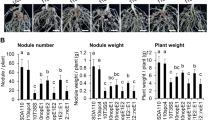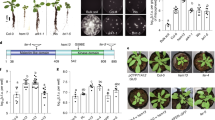Abstract
Legume sanctions against rhizobia that fix less nitrogen should exert a strong selection for more beneficial genotypes of rhizobia, but strains providing little host benefit are common. One reason may be that some rhizobia chemically manipulate the host, undermining the efficacy of sanctions. Here we show that the ethylene inhibitor, rhizobitoxine (Rtx), is an example of such a manipulation. Rtx-producing rhizobia decreased legume growth, but benefited relative to an isogenic, non-producing strain on the same plant by accumulating 47% more of the storage lipid poly-3-hydroxybutyrate (PHB).
Similar content being viewed by others
Introduction
Rhizobia are soil bacteria known for fixing N2 in legume root nodules. Strains that divert resources from N2 fixation to their own immediate reproduction, or to synthesis of poly-3-hydroxybutyrate (PHB) to support later reproduction (Ratcliff et al., 2008), could potentially outcompete more mutualistic strains in other nodules of the same plant (Denison, 2000; West et al., 2002). However, host sanctions against nodules that fix little N2 reduce reproduction of cheating rhizobia by half (Kiers et al., 2003). Given host sanctions, why are less beneficial rhizobia still common in some soils? Two possibilities (Kiers and Denison, 2008) are that they escape sanctions by sharing nodules with more mutualistic strains, or manipulate their hosts biochemically, thereby avoiding sanctions despite poor performance.
Some rhizobia make the ethylene inhibitor, rhizobitoxine (Rtx), which increases nodules per plant and competitiveness for nodule formation (Duodu et al., 1999; Yuhashi et al., 2000; Okazaki et al., 2003). Increasing the number of nodules formed by a plant will not increase an Rtx strain's relative fitness (proportional representation in the population) unless Rtx rhizobia are disproportionately represented in the additional nodules, but other fitness benefits are possible. Rhizobia could benefit by using Rtx produced inside nodules (Ruan and Peters, 1992) to manipulate the host into forming larger nodules (allowing more rhizobial reproduction inside), or by increasing their synthesis of PHB to support later rhizobial reproduction (Ratcliff et al., 2008). However, the carbon cost of either excessive nodule growth or PHB synthesis could decrease the fitness of the legume host. Rtx production can increase nodule size (and presumably, rhizobia per nodule) in Vigna radiata (Duodu et al., 1999), but no effects on PHB acquisition have been reported. Here, we examine the effect of Rtx on Siratro growth and nodulation, rhizobial reproduction and PHB accumulation inside nodules.
Materials and methods
We used USDA61, a wild-type Rtx-producing Bradyrhizobium elkanii, and the isogenic Rtx(−) Tn5 insertion mutant, RX18E (Ruan and Peters, 1992). Six Siratro plants (Macroptilium atropurpureum cv. Siratro), grown in pouches, were inoculated with either 105 Rtx(+) or Rtx(−) rhizobia, or with 5 × 104 rhizobia of each strain. Plants were grown as described by Ratcliff et al. (2008) for 12 weeks before harvesting. At harvest, nodules were randomly sampled; rhizobia per nodule and PHB per cell were determined flow cytometrically as described earlier (Ratcliff et al., 2008), but using forward scattering (FSC), calibrated against Nile Red fluorescence. Calibration data came from two preliminary experiments in which plant growth, nodule harvest and analysis of rhizobia were as described, but the plants were harvested after 4 or 6 weeks of growth. The plants were oven dried and weighed for biomass. Strain identity in nodules from co-inoculated plants was determined by plating 10 single-cell isolates from each nodule on TY agar (per liter: 5 g tryptone, 3 g yeast extract, 0.66 g CaCl2·2H2O plus 150 μg ml−1 kanamycin) selective for RX18E. Mixed nodules were rare and were excluded from analysis. Statistics were computed with JMP 7.0.
Results and discussion
Forward scatter (FSC) was linearly correlated with Nile Red fluorescence, and thus with PHB (Ratcliff et al., 2008) (P<0.0001, r2=0.87, Figure 1). The intercept was not significantly different from 0 (t=0.08, d.f.=88, P=0.94 two-sided t-test).
Rtx(+) rhizobia reduced Siratro shoot growth by 37% (t=2.29, d.f.=10, P=0.045, two-sided t-test, Figure 2a inset) under single-strain infection. Rhizobia on Rtx(+)-only plants reproduced less: 2.01 × 108 per nodule versus 1.25 × 109 Rtx(−) rhizobia/nodule (t=11.81, d.f.=62, P<0.0001 two-sided t-test, Figure 2a), perhaps because worse plant health limited nodule growth. Nevertheless, they accumulated 96% more PHB than did the Rtx(−) genotype (t=9.82, d.f.=62, P<0.0001 two-sided t-test, Figure 2a).
Rhizobitoxine production by Bradyrhizobium elkanii reduces plant growth (a, inset) but benefits the producing strain. (a) Under single-strain inoculation, which is not representative of field conditions, the benefit of more poly-3-hydroxybutyrate (PHB) was outweighed by less reproduction. (b) With mixed inoculation, Rtx(+) rhizobia still accumulate more PHB than do their Rtx(−) competitors, the but negative effects of rhizobitoxine on plant growth (fewer rhizobia per nodule) are shared. Each point represents one nodule (mean of thousands of cells). Filled symbols are Rtx(−), open symbols are Rtx(+). Error bars=s.e.m.
Single-strain inoculation is useful to measure Rtx effects on plants, but Rtx effects on growth of singly inoculated plants may affect rhizobial fitness in ways unrepresentative of the field, in which several competing strains infect each plant (Hagen and Hamrick, 1996; Silva et al., 1999). Therefore, we tested Rtx effects on rhizobial fitness by co-inoculating Siratro with both Rtx (+) and (−) rhizobia, then assaying rhizobia/nodule and PHB accumulation. Rtx(+) rhizobia gained an average of 47% more PHB than did the Rtx(−) mutant (t=4.49, d.f.=47, P<0.0001, two-sided t-test, Figure 2b). In contrast to single-strain inoculation, Rtx(+) rhizobia suffered no penalties to reproduction, with 6.11 × 108 rhizobia/nodule versus 6.55 × 108 rhizobia in Rtx(−) nodules (t=0.3, d.f.=47, P=0.77, two-sided t-test, Figure 2b), presumably because overall plant health affected both strains similarly. Compared with single-strain inoculation, co-inoculation significantly decreased the number of Rtx(−) rhizobia/nodule and increased the number of Rtx(+) rhizobia/nodule (F3,108=30.62, P<0.0001, one-way analysis of variance, differences assessed at α=0.05 with Tukey's honestly significant difference).
Siratro infected with the Rtx(+) strain alone or co-inoculated with both strains formed an average of 16.2 and 15.16 nodules/plant, respectively, significantly more than the average of 4.5 nodules per plant formed by the Rtx(−) strain alone (F2,16=9.77, P=0.0019, one-way analysis of variance, differences assessed at α=0.05 with Tukey's honestly significant difference). However, in contrast to other work (Yuhashi et al., 2000; Okazaki et al., 2003), we found that Rtx(+) rhizobia were no more competitive than were Rtx(−), founding only 42% of nodules (t=0.84, P=0.42, d.f.=10, two-sided t-test) during co-inoculation. In other words, the increase in nodules/plant caused by Rtx did not increase the relative fitness of the Rtx(+) strain.
When otherwise similar Rtx(+) and Rtx(−) strains often share individual host plants, their equivalent reproduction inside nodules, combined with the greater PHB accumulation of the Rtx(+) rhizobia (Figure 2B), will favor the spread of the latter. Rtx reduces Siratro growth (Figure 2a insert), but this would only reduce the reproduction of Rtx(+) rhizobia relative to an Rtx(−) strain if plants were singly infected (Figure 2), which rarely occurs in the field. There is a metabolic trade-off between PHB synthesis and N2 fixation (Anderson and Dawes, 1990), confirmed by tests using mutants (Hahn and Studer, 1986; Cevallos et al., 1996), but it is not clear how much of the negative effect of the Rtx(+) strain on plant growth was because of increased PHB accumulation. We suggest that production of plant-hormone mimics by rhizosphere bacteria is often manipulation rather than mutualism (Kiers and Denison, 2008). Rtx may not be the only way in which rhizobia inside nodules manipulate their hosts biochemically.
References
Anderson AJ, Dawes EA . (1990). Occurrence, metabolism, metabolic role, in industrial uses of bacterial polyhydroxyalkanoates. Microbiol Rev 54: 450–472.
Cevallos MA, Encarnación S, Leija A, Mora Y, Mora J . (1996). Genetic and physiological characterization of a Rhizobium etli mutant strain unable to synthesize poly-β-hydroxybutyrate. J Bacteriol 178: 1646–1654.
Denison RF . (2000). Legume sanctions and the evolution of symbiotic cooperation by rhizobia. Am Nat 156: 567–576.
Duodu S, Bhuvaneswari TV, Stokkermans TJW, Peters NK . (1999). A positive role for rhizobotoxine in Rhizobium-legume symbiosis. Mol Plant Microbe Interact 12: 1082–1089.
Hagen MJ, Hamrick JL . (1996). A hierarchical analysis of population genetic structure in Rhizobium leguminosarum by trifolii. Mol Ecol 5: 177–186.
Hahn M, Studer D . (1986). Competitiveness of a nif- Bradyrhizobium japonicum mutant against the wild-type strain. FEMS Microbiol Lett 33: 143–148.
Kiers ET, Denison RF . (2008). Sanctions, cooperation, and the stability of plant-rhizosphere mutualisms. Annual Review of Ecology, Evolution, and Systematics 39: 193–213.
Kiers ET, Rousseau RA, West SA, Denison RF . (2003). Host sanctions and the legume-rhizobium mutualism. Nature 425: 78–81.
Okazaki S, Yuhashi KI, Minamisawa K . (2003). Quantitative and time-course evaluation of nodulation competitiveness of rhizobitoxine-producing Bradyrhizobium elkanii. FEMS Microbiol Ecol 45: 155–160.
Ratcliff WC, Kadam SV, Denison RF . (2008). Poly-3-hydroxybutyrate supports survival and reproduction in starving rhizobia. FEMS Microbiol Ecol 65: 391–399.
Ruan X, Peters NK . (1992). Isolation and characterization of rhizobitoxine mutants of Bradyrhizobium japonicum. J Bacteriol 174: 3467–3473.
Silva C, Eguiarte LE, Souza V . (1999). Reticulated and epidemic population genetic structure of Rhizobium etli biovar phaseoli in a traditionally managed locality in Mexico. Mol Ecol 8: 277–287.
West SA, Kiers ET, Simms EL, Denison RF . (2002). Sanctions and mutualism stability: why do rhizobia fix nitrogen? Proc Royal Soc London B, Biol Sci 269: 685–694.
Yuhashi KI, Ichikawa N, Ezura H, Akao S, Minakawa Y, Nukui N et al. (2000). Rhizobitoxine production by Bradyrhizobium elkanii enhances nodulation and competitiveness on Macroptilium atropurpureum. Appl Environ Microbiol 66: 2658–2663.
Acknowledgements
We thank Matthew Parker for rhizobial cultures. This research was supported by the National Science Foundation Grant no. 0514464. WCR was supported by an NSF graduate research fellowship.
Author information
Authors and Affiliations
Corresponding author
Rights and permissions
About this article
Cite this article
Ratcliff, W., Denison, R. Rhizobitoxine producers gain more poly-3-hydroxybutyrate in symbiosis than do competing rhizobia, but reduce plant growth. ISME J 3, 870–872 (2009). https://doi.org/10.1038/ismej.2009.38
Received:
Revised:
Accepted:
Published:
Issue Date:
DOI: https://doi.org/10.1038/ismej.2009.38
Keywords
This article is cited by
-
The direct and interactive effects of elevated CO2 and additional nitrate on relative costs and benefits of legume-rhizobia symbiosis
Symbiosis (2021)
-
Comparative conventional and phenomics approaches to assess symbiotic effectiveness of Bradyrhizobia strains in soybean (Glycine max L. Merrill) to drought
Scientific Reports (2017)
-
The Evolution of Ethylene Signaling in Plant Chemical Ecology
Journal of Chemical Ecology (2014)
-
Population genomics of Sinorhizobium medicae based on low-coverage sequencing of sympatric isolates
The ISME Journal (2011)
-
Measuring the fitness of symbiotic rhizobia
Symbiosis (2011)





